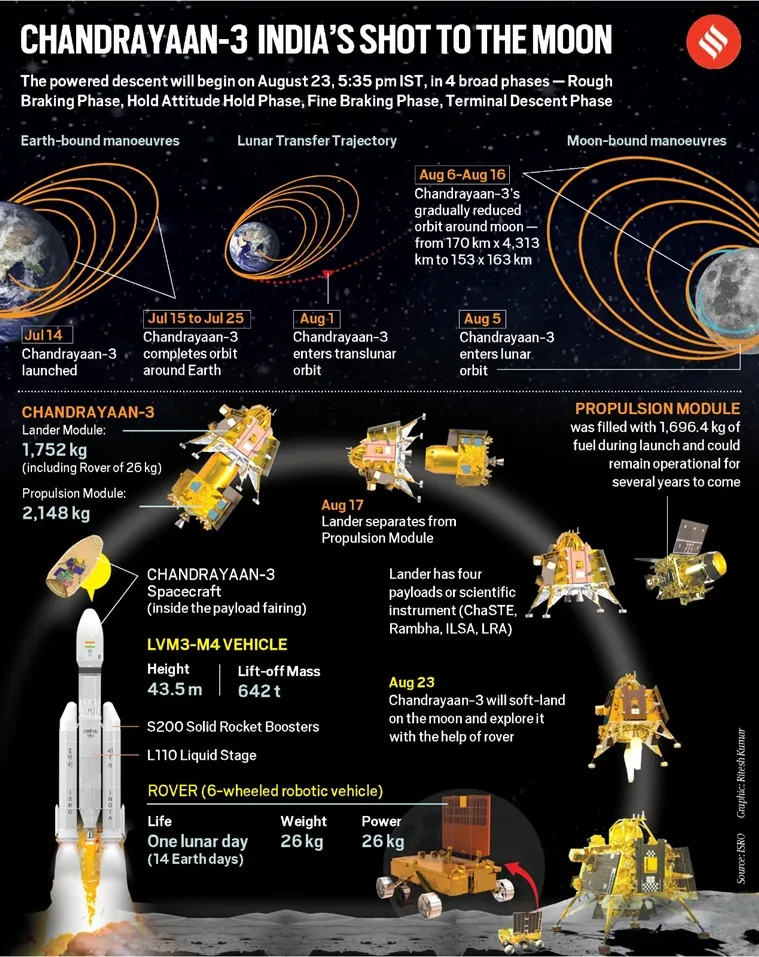Chandrayaan-3 Moon Landing Live Updates
Chandrayaan-3 Moon Landing Live Updates: After a 40-day journey that began from the Satish Dhawan Space Center in Sriharikota, the Indian Space Research Organization (ISRO) Chandrayaan-3 mission is now gearing up for landing. If all goes well, the Vikram lander should make a soft lunar landing on August 23 at 6.04 PM IST. You can watch the live stream of the landing below. It will start at 5.27 PM IST.
Ahead of the launch, ISRO said it was ready to initiate the mission's automated landing sequence. The space agency plans to do it at 5.44 pm IST. From this point, the Vikram lander would attempt a soft-landing on the Moon using its on-board computers and logic.
The Chandrayaan-3 mission is a follow-up to the 2019 Chandrayaan-2 mission, when the Vikram lander crashed on the lunar surface. The mission's primary objective is simple - demonstrate the space agency's ability to complete a soft-landing on the Moon.
If the mission succeeds, India will join the small and exclusive club of countries that have succeeded in soft landing on the Moon. So far, the club has three members - the United States, the Soviet Union and China. Russia made its first attempt to land on the moon since 1976 (when it was part of the Soviet Union) with the Luna-25 mission.
Luna-25 met the same fate as Chandrayaan-2 and the Russian space agency announced on Sunday that it crashed on the lunar surface. Interestingly, Luna-25 aimed to be the first mission to land on the Moon's South Pole - the goal of both Chandrayaan-2 and Chandrayaan-3. Now only India has a horse in the race.
After separation from the propulsion module, the Chandrayaan-3 lander was in communication with the orbiter of the Chandrayaan-2 mission, which has been orbiting the Moon for the past four years.
The Chandrayaan-2 orbiter has already played an important role in the mission by identifying a safe location for Chandrayaan-3 to land. But the former will continue to play a role, acting as a communications relay between the new lander and the ground station. The lander will send data to the Chandrayaan-2 orbiter, which, in turn, will send data to ISRO ground stations and partner agencies.
ISARO LIVE STREAMING WATCH HERE
Major improvements in Chandrayaan-3
ISRO chief S Somnath said the upgrade to the mission was "failure-based", meaning scientists looked at what went wrong in the Chandrayaan-2 mission to improve its successor. Here are some improvements.
Reinforced legs: The legs of the new Vikram lander have been strengthened to ensure that it can land safely at a speed of 10.8 kmph. Of course, this may not be really useful in a situation like Chandrayaan-2, which was traveling at around 580 kmph when the lander crashed.
Larger fuel tank: The Chandrayaan-3 mission carries more fuel than its predecessor to ensure that it can make last-minute changes if required.
More solar panels: The new Vikram lander has solar panels on all four faces instead of just two, as seen with its predecessor.
Additional equipment and improved software: More crucially, the Chandrayaan-3 mission has additional equipment and improvements to its software to aid soft-landing efforts. This includes a laser Doppler velocimeter, which will fire a laser beam at the lunar surface to calculate the lander's speed. The updated software has multiple redundancies that will help it cope with various situations.
Four stages of landing
The "15 minutes of terror" that make up the last moments of the Chandrayaan-3 mission before landing consist of four phases:
Rough breaking phase: During this phase, the horizontal speed of the lander should decrease from about 6,000 kilometers per hour to close to zero for a soft landing.
Attitude hold phase: At an altitude of about 7.43 km above the lunar surface, the lander will tilt from horizontal to vertical while covering a distance of 3.48 km.
Fine breaking phase: This will last for about 175 seconds, during which, the lander will travel about 28.52 km horizontally to the landing site while losing about 1 km in altitude. Chandrayaan-2 lost control between the attitude hold and fine braking phases.
Terminal Descent: This is the final stage when the fully vertical lander must descend to the lunar surface.






No comments:
Post a Comment